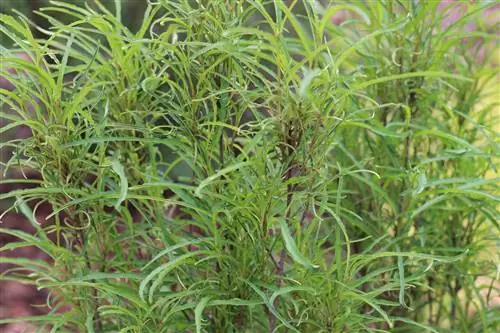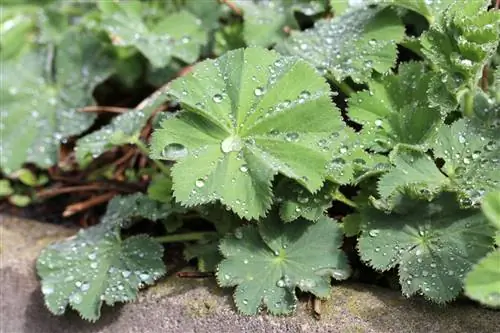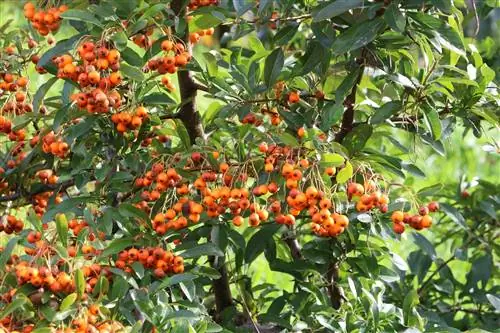- Author admin [email protected].
- Public 2023-12-17 03:39.
- Last modified 2025-01-24 12:45.
The bark of the plant can be used medicinally as an infusion as a laxative. In the past, the charcoal obtained from buckthorn was used as a basis for the production of black powder. Tip: Robust, fast-growing and easy-care, winter-hardy plant that is suitable for less talented hobby gardeners who want to green their garden with little effort.
Profile
- Name: buckthorn, powderwood, Rhamnus frangula
- Growth habit: unreinforced shrub, occasionally small tree, upright, broom-shaped, slender shape
- Family: Buckthorn family
- Leaves: ovate to broadly elliptical, wavy at the leaf edge, two to seven centimeters long, maximum five centimeters wide, but usually smaller
- Fruits: Drupes (inedible for humans), classified as poisonous
- Use: Bark (as a tea-like infusion against constipation)
- Reproduction: self-pollination, cross-pollination or animal pollination
- Root type: Deep-rooted
Sowing
If the buckthorn is to be planted in your own garden by sowing seeds from the garden center, then this sowing is recommended in late autumn. Otherwise, there is nothing to consider when sowing the undemanding buckthorn, except that the preferred semi-shady location should of course be selected.
- partially shaded location for sowing
- Always sow in autumn
Location
The buckthorn appreciates moist soil and a semi-shady location in the garden. Overall, the buckthorn is very easy to care for, which is very pleasant for the gardener because it does not require any special attention in care. Due to its robustness and constant growth even under adverse conditions, the buckthorn was considered a very useless weed for a long time. If the buckthorn is located in partial shade in the garden, it has no further demands on its location. Basically, the plant grows as a shrub with only one trunk, although it can also form several trunks on particularly moist soils.
When choosing a location for the buckthorn, it should be borne in mind that it can reach a height of up to two or three meters. If conditions are very good in terms of soil and lighting, the buckthorn can also grow to seven or eight meters tall. This means choosing the right location or countering the growth with thorough pruning. If you want to offer the buckthorn the perfect conditions, you should ensure acidic loamy clay soil, which the tree also has in nature in sparse forests as well as on watercourses or moors, where it prefers to settle. Otherwise, the buckthorn is very undemanding and can even be found in the Alps at altitudes of up to 1,000 meters due to its undemanding and robust nature.
- moist soil
- partially shaded location
- easy-care plant for inexperienced gardeners
- reaches great heights - take this into account when choosing a location
- an acidic loamy clay soil is perfect as a substrate
Plants
The robust and very easy-care shrub should be planted preferably in late spring into summer. Planting can be done as cuttings. The shrub then grows loosely with a final height of an average of three meters. Initially, the bush produces greenish berries in summer, which then take on a reddish-black color and are about the size of a pea.
Pouring
As unproblematic as the buckthorn is overall, it is also easy to care for when it comes to watering. If it is in a semi-shaded place in generally moist soil, then it only needs additional watering in extreme heat phases of the summer. Otherwise, the plant, which also grows lushly in nature, accepts the water supply that nature offers it.
Fertilize
Hardly any plant is less demanding when it comes to fertilization than the buckthorn. It practically fertilizes itself because it uses its own leaves to obtain nutrients for the new season. In autumn the bush loses its leaves. These can then be piled up directly on the trunk in the garden. As soon as the leaves begin their natural decay process, the soil and thus the root area receive the necessary nutrients in sufficient quantities. Additional fertilization, for example with commercially available liquid or stick long-term fertilizers, is not necessary for this plant.
Cutting
Regular topiary is very good for the lushly growing plant, especially in your own garden, to keep it under control and prevent excessive growth. The topiary should ideally take place in spring and should be thorough during this time. If necessary, the buckthorn can be cut into shape again and again.
- regular cutting is recommended to keep the plant under control
- Topiary cutting in spring, corrections possible at any time afterwards
Wintering
The buckthorn retains its unproblematic character even when it comes to overwintering, because as a naturally occurring plant it is absolutely hardy. No special preparation for the cold season is required here.
Propagate
The buckthorn can be propagated via cuttings. This is particularly common in the USA, while propagation via seeds is more common here. The ideal time for planting cuttings is July to August. Removing shoots for cuttings should be done by cutting, not tearing. This means that the wound area on the mother plant remains smaller and root formation is easier. Rooting hormones promote root formation. Here you should seek advice from a garden specialist, or better yet from a landscape gardener.
Tip:
Try propagation by cuttings, which is rather unusual in this country, as it is uncomplicated and shoots from the mother plant can be used!
Diseases
In general, the plant is robust and undemanding. However, if the care conditions are unfavorable, it can become a popular host for the so-called web moth. With optimal care, disease and pest infestations are unlikely.
Frequently asked questions
Is the plant also suitable for an environment with children?
The berries of the tree are very poisonous and should under no circumstances fall into the hands of children! The plant should therefore not be planted out of the reach of children or in children's surroundings at all!
What does the buckthorn do as a well-known medicinal plant?
In the medicinal sector, buckthorn is one of the anthranoids. These substances trigger a chemical process in which bacterial enzymes are split off from sugar in the body. This reduces the storage of water and s alt in the intestinal mucosa, which in turn regulates or rather accelerates bowel emptying - thus helping against constipation. Preparations made from buckthorn bark can combat these problems in the short term. The buckthorn tree has long been considered a very effective natural remedy for constipation, which also works quickly and intensively.
Tip:
The naturally effective remedy for constipation made from buckthorn bark can be used occasionally. However, long-term use is suspected of promoting the development of cancer. Therefore, the use of buckthorn bark against constipation should be limited in time and, above all, rare!
What you should know about the buckthorn in brief
- The buckthorn is a shrub that is native to many areas of Europe. It belongs to the buckthorn family.
- In favorable locations it can also grow into a small tree up to eight meters high.
- It got its German name because its bark has a slight smell of rot.
- The botanical name frangula, which is derived from the Latin word for break, refers to the brittleness of the branches of this shrub.
Profile
- A buckthorn grows to a height of around two to three meters and usually only has one trunk.
- In particularly humid locations it can also have several.
- It has light green, alternate leaves that are oval in shape and slightly pointed or rounded at the end.
- From the end of May to September it produces small, rather inconspicuous flowers in a greenish-white color.
- Its fruits are berry-shaped and have two or three seeds.
- They are initially green, later turn red and are black when ripe in August.
- Because this shrub blooms for a very long time, you can usually find fruits in different colors on it.
- They fall from the bushes in autumn and are eaten by birds, which then carry the seeds further.
- This shrub has no thorns.
Usage
- The wood of the buckthorn can be used to make charcoal, which was previously used to make black powder.
- For this reason, this shrub is also known as powderwood.
- The bark is used in medicine as a laxative and to treat flatulence.
- Their effects have been known in medicine for many centuries.
In order to be able to use the bark, it is peeled from the branches and trunks in the spring before the flowering period begins and then either dried and stored for a year or treated in ovens at a temperature of 80 to 100 °C. The bark develops glucofrangolines, which have a mild but very effective laxative effect. It is usually used for a tea infusion, but there are also dragees that contain these buckthorn glucofrangolines. Tea blends for spring treatments also often contain some buckthorn bark alongside other herbs.
Toxicity
- Fresh buckthorn bark, however, is poisonous, as are the leaves and berries of this shrub.
- It can cause nausea, stomach pain and bloody diarrhea.
- Because of the beautiful berries, it is therefore advisable not to plant a buckthorn where children often spend time.
But pets and farm animals can also get sick from it and adults should only consume buckthorn bark tea over a short period of time because of the possible side effects. This laxative must not be used at all for children, pregnant women, breastfeeding mothers and people who suffer from intestinal diseases!






